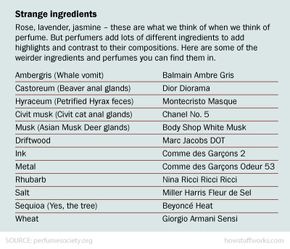What Is Perfume?
In liquid perfume, the liquid is a mixture of alcohol, water and molecules that evaporates at room temperature. "A smell is basically a molecule that's light enough to float in the air, although not every molecule that's light enough to float in the air has a smell -- carbon monoxide, for example," says Avery Gilbert, a sensory psychologist who has consulted for the fragrance industry. What creates the fragrance is that cells in your nose recognize the evaporating molecules and send electrical messages to your brain, which creates a perception. To learn exactly how we smell, read How Smell Works.
If you've read the French phrases on your perfume bottle, you may know that perfumes come in different strengths. The most concentrated are perfume oils. They have been pressed out, steamed out or chemically separated out of a plant, flower or fruit [source: Sell]. In perfume oil, fragrance molecules are dissolved in 98 percent alcohol and 2 percent water. Everything else is alcohol-diluted perfume oil. From most to least concentrated, parfum is at least 25 percent perfume oil; eau de parfum is 15 to 18 percent; eau de toilette is 10 percent; and eaux de cologne and body spray are lighter [source: Turin and Sanchez].
Advertisement
The perfume world also classifies perfumes into scent families. The categories exist because critics and designers use the terms. There are no groupings that everyone agrees on, nor any rule about categorization beyond common sense and a perfume belonging if it smells like the last perfume in the category. Here are some classifications you may have encountered:
- Floral: smells like flowers
- Fruity: smells like fruit, including citrus
- Green: fresh grass or leaves
- Herbaceous: like any variety of herbs
- Woody: like different types of wood
- Amber: like tree resin
- Animalic: bodily smells
- Musk: like a substance made by the musk deer
- Oriental: amber and spice
[source: Turin and Sanchez]
Sometimes perfumes are categorized according to the structure of one of its fragrant molecules:
- Aldehydic: fatty but makes other smells radiate
- Lactonic: creamy and fruity
- Phenolic: smells like tar
Tired of these subjective categories? There are no ambiguities in the chemistry of perfume, except in the secret ingredients, of course. Read on to learn basic perfume chemistry.
